#Ásta Fanney Sigurðardóttir
Explore tagged Tumblr posts
Video
youtube
Ruins by aYia, live at Kex Hostel in Reykjavik during Iceland Airwaves 2018
#music#icelandic music#ayia#kristinn roach gunnarsson#live#kári einarsson#kristinn roach#kari einarsson#ásta fanney sigurðardóttir#eyvindur þorsteinsson#ásta fanney#live music#kevin suggs#iceland airwaves#kexp#justin wilmore#scott holpainen#jim beckmann#matt ogaz#alaia d'alessandro#kex hostel#iceland airwaves 2018
31 notes
·
View notes
Text
Collection of photos related to the play Þetta er allt vitleysa, Snjólfur! (1988) from Guðjón Sigvaldason's Facebook page, who was the director of the show: https://www.facebook.com/gudjon.sigvaldason
Learn more about Þetta er allt vitleysa, Snjólfur! (1988) here: https://stefankarlfanblog.tumblr.com/post/620125846748938240/%C3%BEetta-er-allt-vitleysa-snj%C3%B3lfur-or-as-its-known

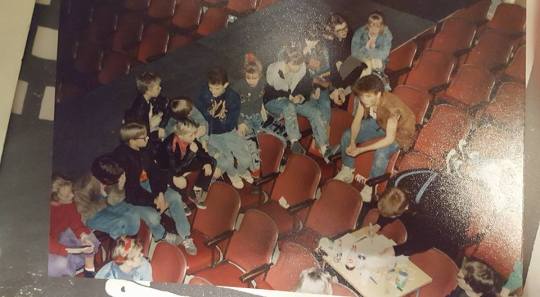
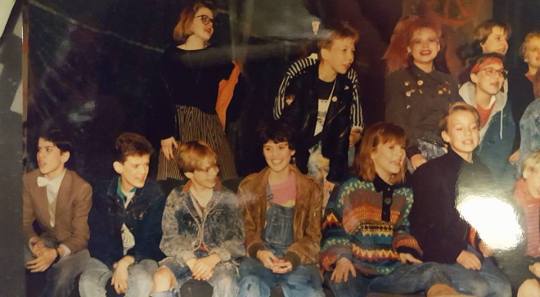
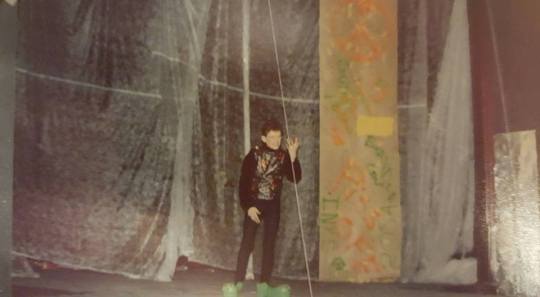
The first photo was posted on the 27th of Septemeber 2017, while the rest are from the 28th. We also now know that Stefán Karl's character was named Konni.
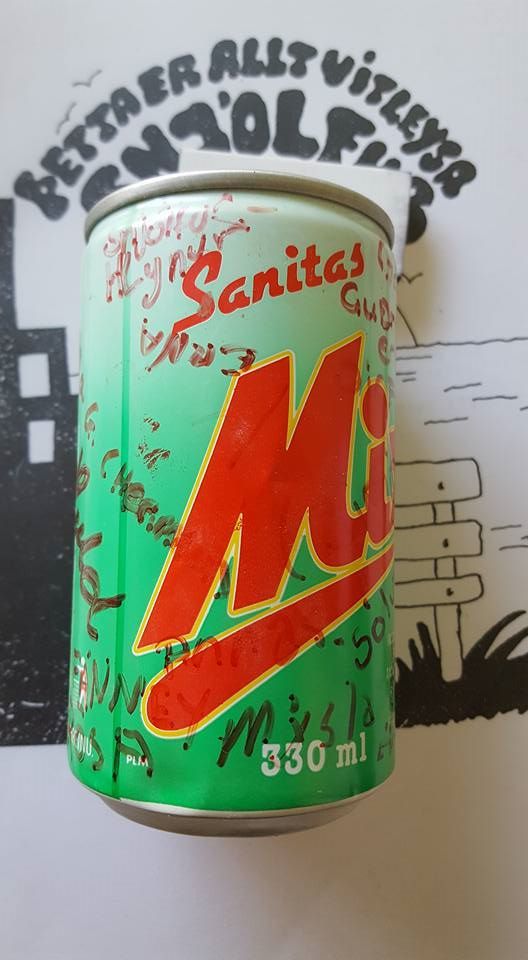
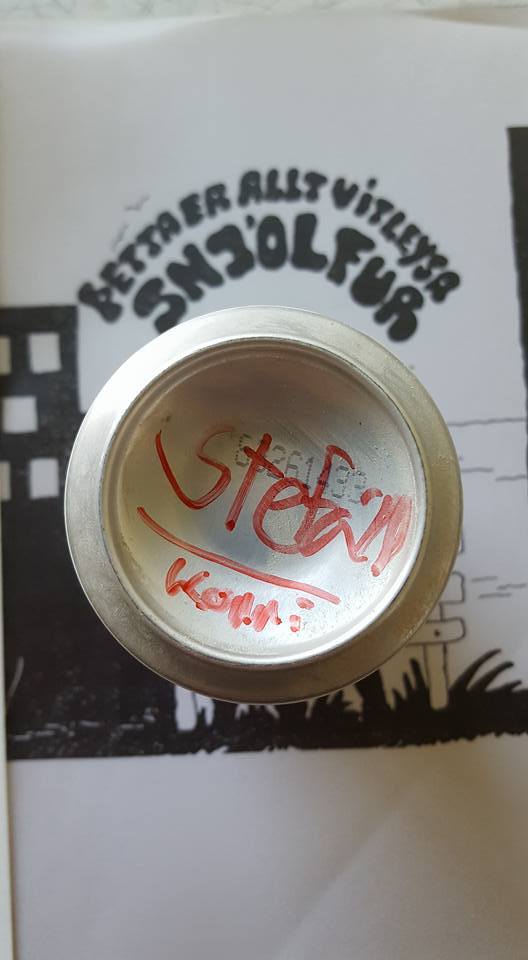
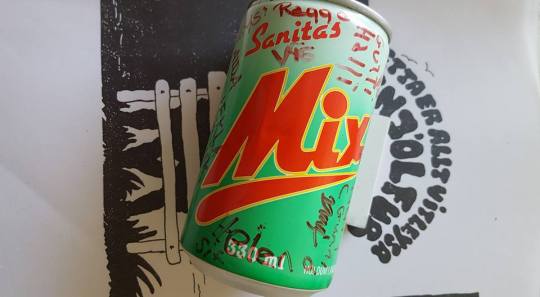
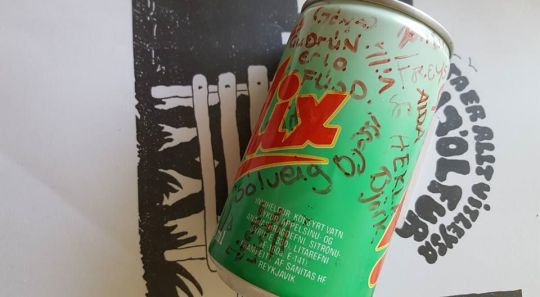
Another post was made on the same day showing photos of a can of Mix with the actors autographs and character name's on them.
Captioned: Ég drakk víst mikið af mix á þessum tíma og fékk áritaða þessa dós í frumsýningar gjöf 😚
Translation: I must have drank a lot of Mix at that time and got a signed can of this as a premiere gift 😚
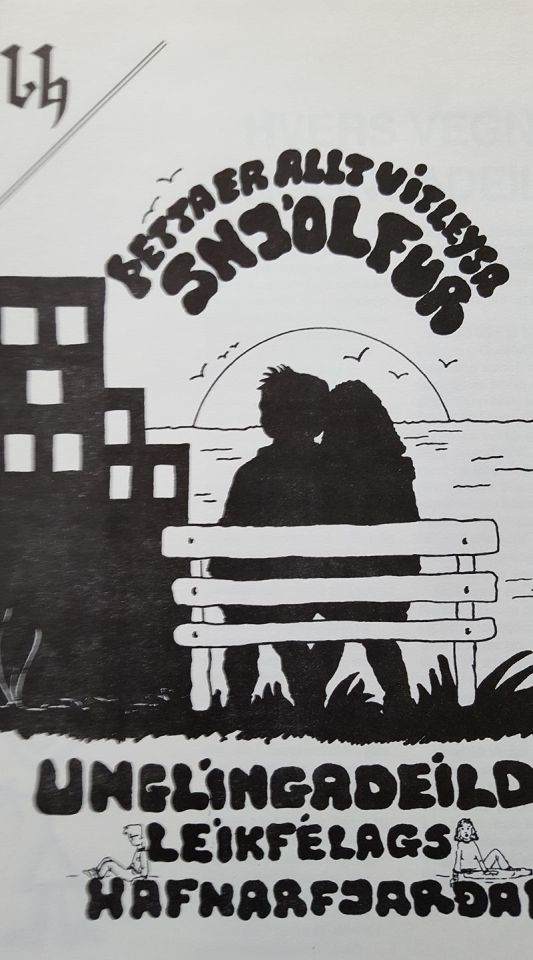
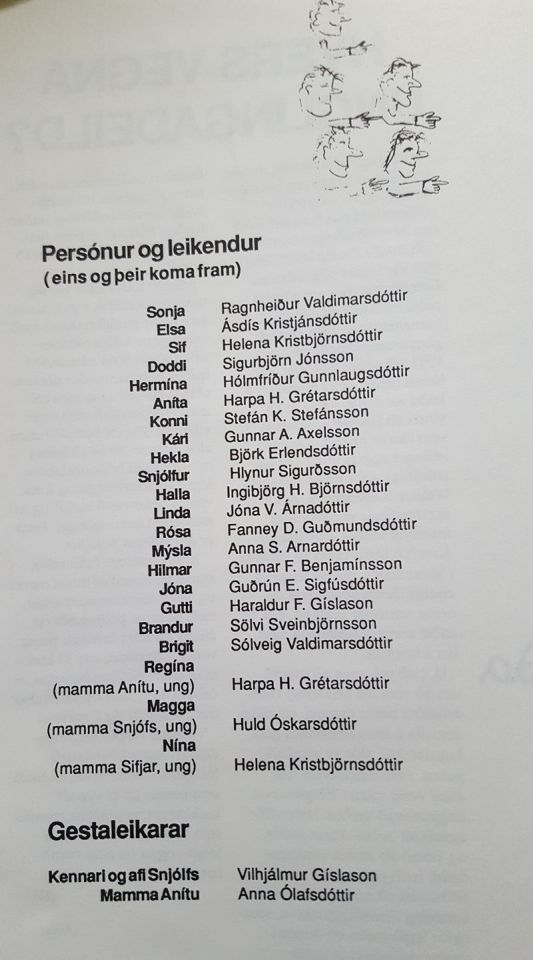

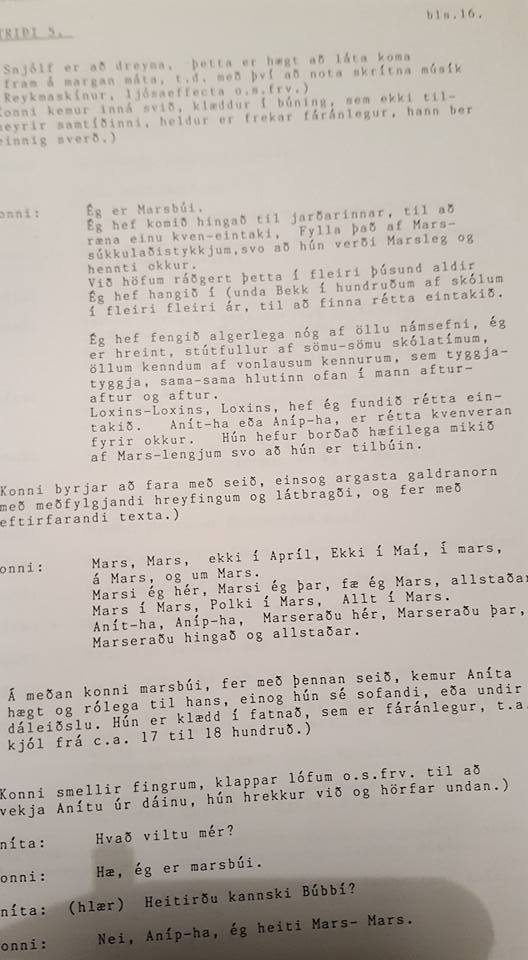
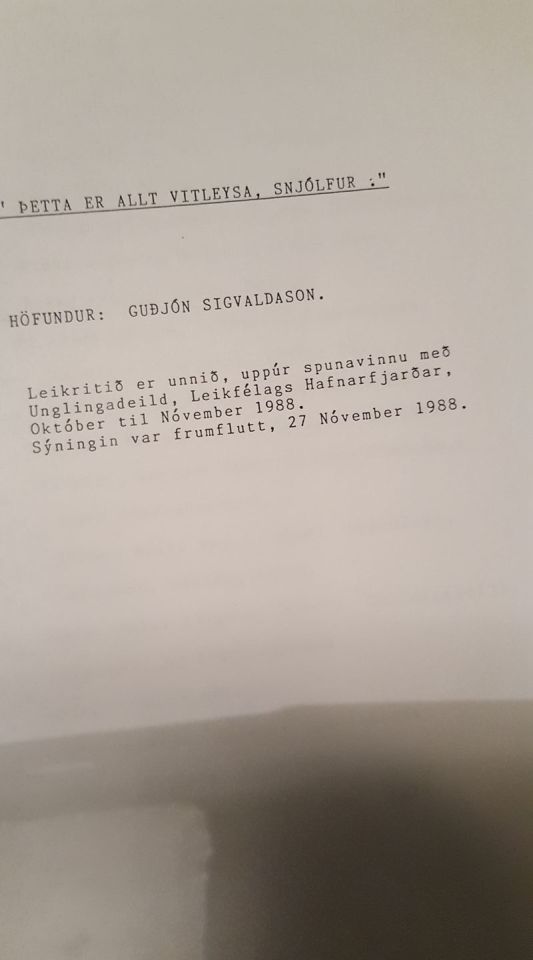
On the 26th and 28th of September he posted photos of the playbook, I'll try to translate what's on the pages under the cut!
First page, the cover:
This is all nonsense, Snjólfur
Youth department Theater club Hafnarfjörður.
Second page, the cast:
Characters and Actors (as they appear)
Sonja Ragnheiður Valdimarsdóttir
Elsa Ásdís Kristjánsdóttir
Sif Helena Kristbjörnsdóttir
Doddi Sigurbjörn Jónsson
Hermína Hólmfríður Gunnlaugsdóttir
Aníta Harpa H. Grétarsdóttir
Konni Stefán K. Stefánsson
Kári Gunnar A. Axelsson
Hekla Björk Erlendsdóttir
Snjólfur Hlynur Sigurðsson
Halla Ingibjörg H. Björnsdóttir
Linda Jóna V. Árnadóttir
Rósa Fanney D. Guðmundsdóttir
Mýsla Anna S. Arnardóttir
Hilmar Gunnar F. Benjamínsson
Jóna Guðrún E. Sigfúsdóttir
Gutti Haraldur F. Gíslason
Brandur Sölvi Sveinbjörnsson
Brigit Sólveig Valdimarsdóttir
Regína (Aníta's mother, young) Harpa H. Grétarsdóttir
Magga (Snjólfur's mother, young) Huld Óskarsdóttir
Nína (Sif's mother, young) Helena Kristbjörnsdóttir
Guest actors
Snjólfur's teacher and grandfather Vilhjálmur Gíslason
Mamma Anítu Anna Ólafsdóttir
Third page, the credits:
Director Guðjón Sigvaldason
Script Guðjón Sigvaldason
Lighting Helgi Bragason
Sound Hilmar Þór Árnason
Props Erna Grétarsdóttir
Makeup Kristbjörg Hjaltadóttir María S. Davíðsdóttir
Keyboard Gunnar F. Benjamínsson
Assistance and other things Ásta Steinarsdóttir Kristrún Gunnarsdóttir Dagný Karlsdóttir
Costumes The group
Set work The group
Chief carpenter Guðmundur Grétarsson
Playbook Egill Ingibergsson Fanney D. Guðmundsdótt Jóna V. Árnadóttir The group
Set design Guðjón Sigvaldason Lyrics Guðjón Sigvaldason Executive Board Alda Sigurðardóttir Cover/poster María Hreiðarsdóttir
Stage crew Vilmundur Þorsteinsson Jón E. Jónsson
Fourth page, script for a scene with Stefán Karl's character:
Snjólfur is dreaming, this can be shown in many ways, e.g. by using strange music, Smoke machines, light effects, etc.) Konni enters the stage, dressed in a costume that does not look contemporary, but is rather ridiculous, he also carries a sword.)
Konni: I'm a Martian. I've come here to earth, to kidnap a female specimen. Fill it with Mars chocolate bars, so that it's a Mars womb and throws us. We've been planning this for thousands of centuries. I've been hanging out with hundreds of schools for hundreds of years to find the right copy.
I've had absolutely enough of all the studying, I'm full, full of the same-same schoolmates, all taught by hopeless teachers, who say-say, the same-same thing to a person over and over again. Finally-finally, finally, I've found the right copy. Anít-ha or Aníp-ha, is the right female being for us. She has eaten a healthy amount of Mars bars, so with that she is ready.
(Konni begins to act like the angriest witch with accompanying movements and gestures, and recites the following text.)
Konni:
March, March, not in April, Not in May, in March, on Mars, and around Mars. I march here, I march there, I get Mars, everywhere, Mars in Mars, Polka Mars, All in Mars. Anít-ha, Aníp-ha, March here, March there, March here and everywhere.
(While Konni the Martian carries on this spell, Aníta comes to him slowly, even though she is asleep, or under hypnosis. She is dressed in clothes that are ridiculous, example, a dress from circa 17 to 18 hundred.)
(Konni snaps his fingers, slaps his hands etc. at Aníta to wake her up from her coma, she is startled and taken aback.)
Aníta: What do you want from me? Konni: Hi, I'm a Martian. Aníta: (laughs) So, are you Bobbi? Konni: No, Aníp-ha, my name is Mars - Mars. (Cut off)
Fifth page, the last page:
"This is all nonsense, Snjólfur."
AUTHOR: GUÐJÓN SIGVALDASON
The play was created from improvisation with the Youth Department of Leikfélag Hafnarfjörður, October to November 1988. The show was premiered on 27th of November 1988.
#stefan karl#stefán karl#stefan karl stefansson#stefán karl stefánsson#robbie rotten#þetta er allt vitleysa snjólfur! (1988)#1988#facebook
5 notes
·
View notes
Photo

Munnhola, obol ombra houp-là (a series of performances) by artist and poet Ásta Fanney Sigurðardóttir
775 notes
·
View notes
Photo

https://www.mixcloud.com/radio_mix_kassette/beyond-human-impulses-athens-2018-fie/ Beyond human impulses. field recordings and more. in april 2018 i stayed in athens to take part in the performance festival Beyond human impulses, i also took part in easter that is a big thing in athens. in these recordings you hear performances of some of the artist taking part in the festival, the back ground sounds, some short clips and other long.... and the sound of the city, singing priest and singing clocks, barking dogs. the sounds don´t come in the order they were performed but random flow and can never give clear perspective of the performances as you need to be there and see and breath it , to feel the whole scope of it. i wanna thank everyone and beyond human impulses for the shared experience. i feel blessed to have been part of Beyond Human Impulses.. her i put a list of the artist and sound as they appear in the mix some with full recordings and others with a small clip. i will also time stamp the show. Erin Honeycutt Homo bulla est Berglind Ágústsdóttir Humming of Venus Friday the long the clocks ring Bryndis Hrönn Ragnarsdóttir Apogee or Nobody Eva Ísleifs introduce the festival Ingibjörg Magnadóttir Woman in Love Friday the long people singing on the street Ragnheiður Sigurðardóttir Bjarnarson Being memories (tiny glimpse) Gunnhildur Hauksdóttir Braid Choir - Solidarity (short part of performance ) Maria Nikiforaki Rain Dance (tiny glimpse) Steinunn Gunnlaugsdóttir be ( short part of performance) Rakel McMahon my ego is here with us tonight Steinunn Gunnlaugsdóttir be (tiny glimpse) in the back ground you hear Aristeidis Lappas very short party clip. the priest sing on good Saturday with the light of jesus Amalia Charikiopoulou Travel around Eva Giannakopoulou At the beach 2 (tiny short glimpse) Gunnhildur Hauksdóttir Braid Choir - Solidarity ( tiny short glimpse ) Katrin Inga Jonsdottir Hjordisardottir Egó Friendly Love bells ring again again and again Snorri Páll Ground Zero orthodox priest sing there magic Kalo Pascha- Christos Anesti Ásta Fanney Sigurðardóttir performance
#Beyond human impulses#field recordings#artshow#performance#Steinunn Gunnlaugsdóttir#Amalia Charikiopoulou#Maria Nikiforaki#Katrin Inga Jonsdottir Hjordisardottir#Snorri Páll#Ásta Fanney Sigurðardóttir#Gunnhildur Hauksdóttir#Eva Giannakopoulou#Rakel McMahon#Eva Ísleifs#Ragnheiður Sigurðardóttir Bjarnarson#Erin Honeycutt#Berglind ágústsdóttir#Bryndis Hrönn Ragnarsdóttir#Ingibjörg Magnadóttir#performance festival
0 notes
Photo
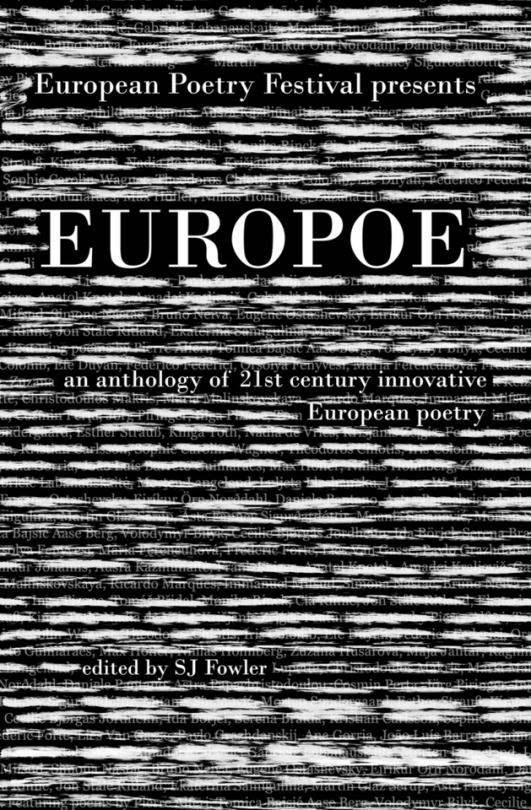

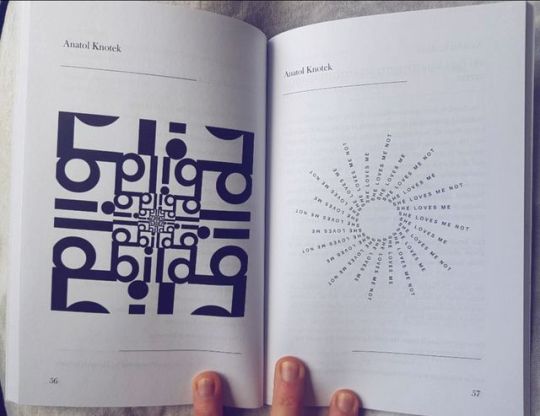

»E U R O P O E« an anthology of european poetry is out now!
groundbreaking poetry by sixty of europe’s most original poets, translated into english, brought together for one remarkable anthology.
kingston university press (may 2019) edited by sj fowler 143 pages. paperback
available to buy here for GBP 9,99,-
“celebrating the grand resurgence in literary and avant-garde poetry that has marked the 21st century in europe, poets from over forty nations present works developing the lyric, sonic, visual, abstract and conceptual traditions. a volume that seeks not to offer a taxonomy but a brief glimpse of the brilliance of so many poets working at the forefront of the language arts, this is a book unified by a fidelity to that which is truly contemporary, amorphously continental and generously innovative.
featuring poems by pierre alferi, tomica bajsić aase berg, volodymyr bilyk, cecilie bjørgås jordheim, ida börjel, serena braida, kristian carlsson, sophie carolin-wagner, theodoros chiotis, iris colomb, efe duyan, federico federici, orsolya fenyvesi, mária ferenčuhová, frédéric forte, lies van gasse, pavlo grazhdanskij, ana gorria, joão luís barreto guimarães, max höfler, niillas holmberg, zuzana husarova, maja jantar, ragnhildur jóhanns, aušra kaziliūnaitė, frank keizer, anatol knotek, amadej kraljevič, gabrielė labanauskaitė, morten langeland, luljeta lleshanaku, léonce w. lupette, christodoulos makris, maria malinskovskaya, ricardo marques, immanuel mifsud, simona nastac, bruno neiva, eugene ostashevsky, eiríkur örn norðdahl, daniele pantano, astra papachristodoulou, cosmin perţa, jörg piringer, inga pizane, tomáš přidal, monika rinck, cia rinne, jon ståle ritland, ekaterina samigulina, martin glaz serup, ásta fanney sigurðardóttir, muanis sinanović, morten søndergaard, esther strauß, kinga toth, nadia de vries, krišjānis zeļģis.
europoe, edited by british poet sj fowler and presented by european poetry festival in the uk, showcases those who are often on the margins of their own nations literary culture, precisely because their work is forward-looking and challenging, alongside some of the most renowned names in europe. europoe is an anthology as a unique document of poetry, marking a moment in time for a modern, and thoroughly european, means of experiencing literature.”
55 notes
·
View notes
Text
A bird clock
i walk slower
today
than yesterday
i went slower
yesterday
than the day before
i haven’t had a look at the clock for a month
i count birds instead
one and it’s one o’clock
two and it’s two o’clock
three and it’s noon
it has changed
running slow
around and around and around
i’m nearly becoming a timeless woman
a loner
a living room loafer
there are dolphins in the canal
there are penguins on telly
there is no paper on the shelves and the mountains are visible
not every one can afford the nature
said the money man and polished his watch
yet every one turns into soil
(there’s a council for tranquility now)
(there’s a council for soap now)
(there’s a council for time now)
(there’s a council for hand sanitizer now)
(there’s a council for 2 metres now)
(there’s a council for gatherings now)
(there’s a council for fake information now)
(there’s a council for real information now)
(there’s a council for people traveling domestically now)
(there’s a council for touch now)
(there’s a council for hugs now)
(there’s a council for change now)
i connected my head
to the head in the ground
and the head became a red net
and the red net became understanding and feeling
sensitive, light, enchanting, powerful
and disappeared little by little
i had to do this again and again
to connect
to renew
between the red threads
in the meshes of the net
there was nothing and silence
and brightness
white
___________________
ÁSTA FANNEY SIGURÐARDÓTTIR
0 notes
Text
(REVIEW) Pain Journal Issue 3

In this review, Maria Sledmere draws out the material poetics of intimacy, glimmer, memory and salt in issue 3 of Pain Journal, from Partus Press, asking what kinds of dream-writing and ecopoetics we might find among the tangle, the camaraderie, the trace.
> Pain is an immaculate journal of new poetry and short, creative essays, edited by Vala Thorodds and Luke Allan, published by Partus Press and designed by Studio Lamont. Folding out the cover of issue 3, you’ll find an epigraph from Robert Creeley’s ‘The Flower’: ‘Pain is a flower like that one, / like this one, / like that one, / like this one’. Pain is a making, a sap, a sort of seedling and fruiting of where we are in the years. It likens itself to more than we’d tend to acknowledge. A blood, a fur of skin, a flower. It’s such a luxury to hold issue 3 in its peachy, matte dust jacket, admiring the beautiful type and the list of contributors. There’s an air of the covetable to Pain: maybe it’s the print quality, maybe it’s the poetry, maybe it’s the curation. I think it’s also something to do with the cover, dominated by the sans serif title PAIN: when I read this walking in the street, I make some kind of statement. It feels charged with the ambiguity of some high fashion statement, and yet what lucky readers are we that something of the contents may tell the pain — we don’t just wear it.
> Where to start! These are lush poems of communication, intimacy, sensation. Ásta Fanney Sigurðardóttir’s ‘Gleam & delicacies’ is a surreal and elliptical lyric of superstitious glimmer. Poetry as ‘a trap for the superstitions’. I find myself googling what a ‘glowfruit’ is and find some reddit discussions around the appearance of ‘glowfruit trees’ in Sims games. There’s this line, ‘I still have wild glowfruit trees. Do you?’, which feels like a summons, a challenge. Enter into this logic with me, where the one-time event of the glowfruit’s arrival has seeded the game’s eternal time. Someone comments, ‘They seem kind of random to me’. I had forgotten the magic of games and their luxurious richness and dream logic of glitches and hacks and splintered paths of narrative. Perhaps my childhood adoration of Sega and Nintendo was my way into poetry. The opening veils of an overlain world. Sigurðardóttir’s poetics have that quality of drifting between rooms and scenes, or falling between bodies and scales by one gesture of a linebreak, the slide of a button control, ‘I give birth to suns / for the morning hoax / slippery planets’. It reminds me of David O’Reilly’s video game, Everything, where you can move between a roving shrub, a celestial body and an oil rig in the space of ten minutes. What is meant by a ‘nighthaired waiter’? There is a dream-hand that extends to our proprioceptive venturing, that offers casual refusal (‘I didn’t come here to toothbrush the wolf’) by way of assembling the real and its purpose. The real which feels more like a ‘silhouette’.
> Significant, perhaps, that this poem of mirror-tricks and shimmers stands opposite Ruby Silk’s ‘Re:’, a poem that takes the banal conceit of email and pulling on tights in the swimming pool changing room to figure something of desire and its thirst. ‘we communicate drily’, the poem begins, ending with a slide on the nature of being quenched, on the question. Both poems forego punctuation, and more or less carry themselves on the turns of language: objects form a multiple syntax of moving between. Their cleanness on the page is perhaps what makes them gleam, they seem to hold their own. The gleam is present elsewhere in the issue, with Eloise Hendy’s ‘scrubland’ beginning, in the manner of Marianne Moore moving into Plath territory, ‘i too have a gleaming future. / a future like a fish scale, the eye / of a small bird’. Trauma or remembered pain is a matter of scale(s) and perception, of the body and its existential whittling, whitening. The speaker asks about whiteness, light, memory and dream: ‘all that spilt milk. all that gleaming’. You could say the gleam is metonymy for shame, the beaming cheeks, the sense of glowing or almost burning there in the situation. No capitals, a whittling. The idea of ‘nonsense’ itself, whittling down to the first gleam, its tender origin: ‘as a girl i was very soft’. The way the lines and stanzas slip, enjambed between, the idea of a passing through. The speaker offers her hurts: her fish eye, her pale appetite, her starved future, her dreams of fish bones and choking. ‘be gentle with me’, she implores. I think of this line from the film Lady Bird (2018), after Lady Bird loses her virginity under a pretence of shared experience and the boy Kyle is like ‘Do you have any awareness about how many civilians we’ve killed since invasion in Iraq started?’ and she replies, ‘SHUT UP. SHUT UP. Different things can be sad. It’s not all war’. ‘as an adult i am softer still’, Hendy writes, as though softening herself into the palest ghost and somehow becoming defiant, ‘my hand / is an arrowhead. a future / like a fish eye’.
> It’s no surprise that Pain is tinged with other existential tremors, those of the body and the world, of ecology and domesticity, of sex and dust. Helen Charman’s ‘In the pocket of Big Pig’ wears high theory cool on its sleeve as it sweeps into the muck and dirt of where we are. The movement of ‘manmade’ materials into the ‘natural’ is an aesthetic act: ‘Plastic / can holders entwine themselves around the / sea kelp — to tame and smooth frizz’. In that em-dash I feel the lines reaching out, the kelp and the twine and the human arms, the bristles. Does poetry do more than brush back the mess of the world, or tease it back into static? What are the ethics of pain’s poetic entanglement?
ecopoets try again and again to convince us of the whiteness of the snow drift. I like muddy ducklings dirty reedbeds
(Charman, ‘In the pocket of Big Pig’)
If ‘muddy ducklings’ has that childlike assonance of storybook rhyme, ‘dirty reedbeds’ feels adult, insistent, dark. The place where you tangle and possibly drown. Turning away from the pristine ‘snow drift’ that pulls us into the picturesque, an ecopoetics that continues the aesthetic throwback of nature poetry before it, this is an anthropocene poetics of living in a fraught, affectively entangled now: ‘I think we’re nostalgic for more than VHS when we / fuck in front of the Blue Planet poster misty-eyed as if / we’ll ever get to show the oceans to our own kids’. Sex is ambivalently yoked to procreation in the ‘misty-eyed’ act of fucking to get back to something primal, deep and planetary. The world as it once supposedly was and exists now mostly as mediation: scenes on tv, posters for Blue Planet. And the word ‘fuck’ for sex that feels iterative rather than tender, two bodies trying to make something of what they have, an intensified point in time and space, a mediation or trace of each other.
> A similar kind of iterative sweetness and friction occurs in Jack Underwood’s ‘Behind the Face of Great White Shark’, where some new entry to the ecosystem upsets the home, ‘Since we brought you home from the hospital / I have begged these hours to a stub’. Enter the metaphoric playground of sharks and dogs, worms, rats, beans and bananas. Something of this new love, the baby perhaps, the shark or the tender thirsty thing at dawn, is a hurt: ‘I admit I have been sick / since we met, pursuing this love-wound / like a moon beyond the windscreen’. A love you’d drive to all through the night, to arrive back where you started, chaste in your own ‘dawn kitchen’ with a moony look in your eye. I think of Dorothea Lasky’s ‘wild lyric I’, the one she discusses in her new book Animal: this playful and manipulative ‘metaphysical I’ that ‘can harness all fragmented senses of self and use them whenever it needs to’. Underwood’s I thrashes like a shark on the sick shores of a new love, a birthing tide, dark and light. An I that threatens violence, desire from all angles and limbs ‘fucking ambidextrously’; an I that ‘can keep you safe inland’, that pulls you into its glow, for this is just ‘the lesser work of living’.
> It is tricky to identify highlights from a journal where, as with amberflora (whose sensibilities resonate here), the selections are impeccable: focused, resonant, but also lovely alone. Nina Mingya Powles’ ‘The Harbour’ has something of Clarice Lispector’s radiance, pressed into a teeming poetics of its own. Its section titles add an epistolary quality, italicised as they are, ‘Dear whales,’, ‘Dear dreamer,’. Post-Arika, with all talk of Moby Dick and the mathematics of the whale, it seems these cetaceans are having a real moment. Powles’ address to the whale is elegiac, ‘I can pinpoint all the places you have died, / where I’ve buried you’. She’s putting pressure on the work of metaphor, the whale as so much more than whale, the whale as what cannot be contained, the whale that cannot contain itself. Her whale is more of a comrade, a friend:
When I looked out of the train and saw your deep blue body and you saw mine you stayed close to me, swimming alongside. We were both travelling home.
What if ecopoetics, or anthropocene poetics, were something more like this surprising camaraderie? Does it matter whether the encounter was imagined or actually happened? Running through Pain is this suffering silk with its shadows and texture of echo and gleam, ‘the dream is wet skin against her hands / the fact is echolocation’ (Powles). I’ve been thinking about what the tensile ethics of this fugitive touch are: the touch of the image, the whale and the speaker on the train, the relative distance of speed and time between them, the hospitality she extends to the animal she is also. ‘I’ll show you my mother’s potted orchids’, in a world where to cross one human threshold is to know that later the sea will be deep enough for you once more. Pain asks how much of each other we need to hold. There’s this passage from Hélène Cixous’ novel Hyperdream (2006) that speaks to this:
I hear it, I hear a murmur your skin speaks, a blood thinks, I hear your thought running under the skin I hear your life thinking under the neat eternal spotless silk. I read with my life. I am torn. At the same time I am healed and glued back together again. During this time the world suffers and dies [...]
What is the murmur of our speaking skins, our thinking blood? The body that dreams? One pain can open the next, there’s a gesture of infinity, the way that Anne Boyer identifies in her ‘meditation on modern illness’, The Undying (2019): ‘My new calamity meant it was possible to feel every cell at once and, in these, every mitochondrion, and that it was possible, too, to have a millionfold shitshow of sensations in locations newly realised’. To have your body illumined, intensified, surged to the end of each nerve and cell with this searing consciousness. When I had shingles, I felt real dreams; they seemed to extend to a million tips, concentrated in clusters on the skin of my belly. Real dreams/real hurt. Is a body in pain the body that dreams the most, from her almost-paralysis in sensory excess? I think poems like Powles are asking these questions, declaring, spacing, opening up, leaving us on the brink of a blank that is its own quiet sublime, ‘everything is so !’. And if ‘the fact is letting go’, what of the fact have we been holding all along? Is this like Creeley, gesturing towards this or that flower, as a way of describing, to insist on it. Something we ask as children: does a flower or a plant feel pain? Pain, pain. There it is in the world, it just is, like a flower, or something more tiny and abrasive, salt after salt. A period.
> Rowland Bagnall’s essay ‘The Metal We Call Salt’ closes the journal with a meditation on the poetry of Philip Levine and Elizabeth Bishop, writers who ‘[address] the delicate failure of poetry to say the things which can’t be said’. This is Creeley, surely, with the flowers which stand for the shapeless pain. I’m reminded of a line from Rachael Allen’s ‘Kingdomland’: ‘the glass and salt my crooked pathway; impassable glass and salt’. The glittering remainders which excoriate the entry and exit of threshold, painful debris of the sea. This is the ‘tantalising’ poetics that Bagnall writes of, words that ‘say that they are lost for words’, words that gift and withhold by their material gesture: words that carry traces of what they may be. Salt-tanged and gleaming as glass. ‘What got revealed when the layers of leaves / Were blown backwards?’ Ralf Webb asks, in his ‘Three Sonnets’. What is it to walk over the crunching ‘pathway’ of such poems for pain, ana-cathartic as they move into, above, through, around and from the wound and its ferric sting? The essay also looks at the paintings of John Salt and photographs of Mark Ruwedel, considering how as a preservative and purifier, salt as both an archival and corrosive mineral: art as what consumes and reveals, what glints with the not yet spoken. Salt in the wound for pain will sting, but it will clear. These poems are such interfusions, sweetness and dreams, the ‘torn’: healed and suffering of a life and a world, coming over. And, for just a while, Pain will hold you together, soft in its peachy embrace.
Pain issue 3 is out now and available to purchase here.
~
Text: Maria Sledmere
Published: 5/1/20
0 notes
Video
vimeo
AYIA - SLOW (Official) from axlsouetre on Vimeo.
Directed by Alexandre Souêtre Director of Photography - Ryan Neddeau Produced by Mike Burgess
ICELAND:
Mask Maker - Marly Hall Performances - Geoff McAuliffe, Selma Reynisdóttir & Kristlín Dís
Special Thanks - Geoff McAuliffe, Colm O’ Herlihy, Bedroom Community, Greenhouse Studios, Gyða Valtýsdóttir, Ásta Fanney Sigurðardóttir, Kristinn Roach Gunnarsson, Kári Einarsson, Reykjavík & its people for the warm welcome.
USA:
Performances - Kennedy Dawn, Pete Bauer, Taiyo King, Kyle Berzle, Linnea Stephan, Alix William, Marcell Herd & David Már Hafsteinsson
Special Thanks - Raquey Strange, Alix William, Joe King & everyone who came out, shared their talent, helped & supported.
0 notes
Video
vimeo
AYIA - SLOW (Official) from axlsouetre on Vimeo.
Directed by Alexandre Souêtre Director of Photography - Ryan Neddeau Produced by Mike Burgess
ICELAND:
Mask Maker - Marly Hall Performances - Geoff McAuliffe, Selma Reynisdóttir & Kristlín Dís
Special Thanks - Geoff McAuliffe, Colm O’ Herlihy, Bedroom Community, Greenhouse Studios, Gyða Valtýsdóttir, Ásta Fanney Sigurðardóttir, Kristinn Roach Gunnarsson, Kári Einarsson, Reykjavík & its people for the warm welcome.
USA:
Performances - Kennedy Dawn, Pete Bauer, Taiyo King, Kyle Berzle, Linnea Stephan, Alix William, Marcell Herd & David Már Hafsteinsson
Special Thanks - Raquey Strange, Alix William, Joe King & everyone who came out, shared their talent, helped & supported.
0 notes